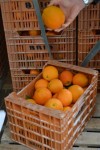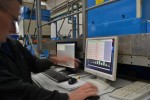http://www.culturespain.com/?p=3181
Valencian oranges
Valencian oranges are world renowned for their sweetness, size and extraordinary colour. Although they are now grown throughout the world, you can still not better Valencian oranges grown and harvested in their native soil in Valencia, Spain.
In fact, one of the most notable aspects to Valencia Province in Spain is the extensive evergreen citrus groves that extend as far as the eye can see. Here, depending upon the time of year, the landscape can appear, quite literally, orange as the citrus groves become laden with ripened fruit. It is an extraordinary sight and is complemented by the blossoming of the orange trees in April – when the surrounding countryside is filled for weeks with a heady scent that is utterly enchanting!
However, what happens between seeing ripened Valencian oranges on their trees and then their appearance on your supermarket shelves?
Well, the straight answer is that a good deal more work occurs than you could ever imagine! Indeed, ensuring that the Valencian oranges that you buy in the UK or elsewhere are almost perfect – takes considerable work and a high degree of skill.
Recently, I was taken around the Brio Fruits processing factory in Gandia, Valencia Province to see what occurs after the oranges have been picked. Brio Fruits was the perfect place to go, as Brio Fruits have been operating for the past thirty five years. They also have a justified reputation for producing the highest quality Valencian oranges available to the market.
Indeed, Brio Fruits success stems from ensuring that their oranges have the highest standards of quality control available – and the chances are that you will have come across them yourself. Almost certainly, you would recognise them for their almost flawless colour, immaculate texture and, needless to say, succulent taste.
“Quality control is everything when it comes to providing the market with top quality fruit,” states Louis González, sales manager for Brio Fruits. “In fact, in the business, we say that consumers ‘eat with their eyes’! So, not only do we have to ensure that the oranges are good to eat – they must also look perfect.’
To achieve success at the top end of the market means that Brio Fruits have had to construct their sales around a factory that does far more than merely obtain local oranges from farmers and then distribute them to international supermarkets. In fact, their Valencian oranges go through 11 stages before being placed into delivery lorries to take them to their end destination..
Valencian oranges – the process from picking to packaging
(as done by Brio Fruits)
1. Harvesting the oranges.
The harvesting of the oranges is undertaken by Brio Fruits – not the farmer. This is so that only the best oranges are chosen and that the oranges are harvested at exactly the right time. Equally, the way that the oranges are removed from the trees is vital. If they are not reoved correctly then the oranges can be damaged. Commonly, this occurs when the person cutting the oranges grazes or punctures the skin .
2. Receipt and storage of the oranges
Valencian oranges normally arrive from the citrus groves in a a 20’ lorry, which will typically hold some 17 tons of oranges in plastic crates. These are off loaded and placed into cold (not freeezing!) storage. They are left there for the shortest possible time before being transported to a special size testing section. This machinery measures the oranges if they are from a different area than those going through the main factory at the time. Once the sizing has been assessed, the oranges go through their first selection process.
3. 1st Selection
The oranges are tipped onto a conveyer belt which washes the oranges before they are transported on a conveyer belt beside workers who remove any obviously defective oranges. One area has an ultra-violet light that shows up marks and defects making it easier for other workers to see any problem oranges.
4. Brush cleaning
The oranges travel through a section that brushes the oranges clean before transporting them onwards
5. Vegetable wash
This is an inert wash that brings out the colour of the cleaned oranges.
6. Drying area
The oranges are dried and now appear on the conveyer belt – positively glowing with colour!
7. Sizing and hi-tech. quality control
The oranges now pass through an extraordinary hi-tech machine which photographs each and every orange (three times) as it passes by! This machine (incredibly!) weighs each orange, measures its diameter and assesses it for defects internally – particularly to see if it has suffered from frost damage. Any defective orange is separated and binned.
8. Hand checking of oranges
The oranges continue along a conveyer belt which divides the oranges into four areas, each of which has workers physically checking the oranges. Defective oranges are re-directed and some oranges that have been mistakenly marked as defective are returned to the main conveyer belt. According to Louis González this element of the quality control is vital. ´The machines are brilliant,’ he says, ‘but for ultimate quality control there is nothing better than skilled eyesight and touch from a professional orange quality control expert to find defects’.
9. Sizing and colour control
The remaining, quality oranges then go through another hi-tech machine which sorts the oranges by pre-programmed size and colour.
10. Packaging
The oranges (now sorted by size and colour) are directed to the packers. These carefully select the oranges (removing any defective ones that have escaped the attention of the machines and other quality control experts) and pack them into cardboard crates.
11. Final packaging
The oranges in their crates now proceed down the conveyer belt to where they are labelled, finally checked (looking brilliant!) and transported to the waiting lorries.
The activity at Brio Fruits in fascinating and the degree of quality control extraordinary. However, the speed and efficiency of all of this is impressive with the time taken between an orange entering the factory and leaving it fully checked and packaged – taking little more than an hour.
In fact, the factory can handle some twelve tons of oranges an hour – which amounts to something like 9,250 oranges! Annually, Brio Fruits will deal with some 12 thousand tons of oranges…
The interesting thing about the quality control of Valencian oranges is that about half of all the oranges picked never reach the supermarket shelves. This is due to natural defects, transport inefficiencies – and the overriding demand for perfection by the end-consumer (or at least the supermarkets buying the Valencian oranges).
Finally, one of the unknown (to me) complications for any fruit distributor is the market itself. ‘The price and demand for Valencian oranges,’ says Louis González, ‘changes daily. This means that we have to react to the market constantly – which can be very stressful. I am constantly in the factory finding out what is going through the system and what we have and how to sell it at the best possible price.’
Clearly, selling quality Valencian oranges is not simple. However, the sheer enthusiasm of the staff at Brio Fruits was impressive – together with their obvious pride in being the producers of the best quality oranges in the world.
‘I have worked here for the past eight years and I love the work,’ says Louis. ‘You know, I can tell from my office what is happening in the factory just from the sound it makes. It is like an orchestra, as different machines start up and the factory foreman changes staff from one place to another. I can tell just which type and size of oranges or other fruit are being processed and, from that, what the international market is asking for at the time.’
Fascinating!
Meanwhile, I now have a crate of absolutely perfect and salivatingly fresh Valencian oranges at home. This crate was picked at random by the factory floor manager and given to me whilst I was photographing the finished crates. Frankly, the oranges look too perfect to eat – but then the chances of them remaining untouched, once my wife sees them, are slim indeed…












- via Feeddler RSS Reader








No comments:
Post a Comment